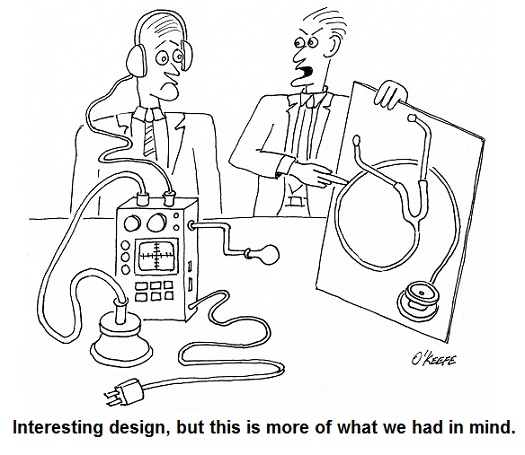|
Who hasn’t finished a project, only to discover that you’d done something wrong and the whole thing would need to be redone? Perhaps you hadn’t checked your work along the way, confident that all would be well in the end. Imagine the costs involved if this scenario were to take place on a commercial production line. The Systems Engineering Approach to things helps ensure this doesn’t happen. Last time we wrapped up our discussion on the Production stage of the systems engineering approach to medical device design, and today we’ll cover the final stage, Utilization. The Utilization stage marks the point at which the medical device has been sold and is in actual use in the marketplace. Despite the fact that the product has at this point undergone many reviews and revisions and a great investment has been made into deciding whether or not to put it into production, changes can still take place in its design. Markets aren’t static, and products may be made to change due to stakeholders’, that is, those with a vested interest, changing requirements, whether those are aimed at further cost reduction, or perhaps to implement innovations to make the product more appealing to end users. Other reasons for change may be initiated by the sales and marketing departments. They keep their fingers on the pulse of consumer trends, and they may want the design modified according to market research and feedback they receive from dealers, service technicians, and end users. For example, the sales staff may have been apprised by end users that the keypad to their electronic muscle stimulating device needs modification. Patients have voiced they would prefer to here a clicking sound when depressing the buttons, in order to receive some auditory feedback. In addition, distributors of the device reported that although the electronic stimulators were functioning as intended, end users didn’t like the feel of the buttons. The lack of tactile feedback often led to confusion because they weren’t sure whether they had depressed the button or not. Another interesting discovery concerning lack of feedback was that product service technicians were reporting premature wearing out of the keypads. Absent the satisfying click sound, users were inclined to push on the pads too strenuously, which drove up warranty service costs. The medical device manufacturer’s stakeholders are always concerned with costs, and increased service costs definitely raise the red flag. Considerations like these typically arise after a medical device enters the Utilization stage. Fortunately, the objective of the systems engineering approach is to ensure that stakeholders’ needs are met in view of ever-changing requirements, even after the device has entered the marketplace. No matter what may happen during the life cycle of a product, the systems engineering approach is used every step of the way, from the Concept stage through to Utilization. That ends our discussion on the systems engineering approach to medical device design. Next time we’ll begin unraveling some of the mysteries and misconceptions behind patenting inventions. ___________________________________________ |
Engineering Expert Witness Blog
Published by Philip J. O'Keefe, PE, MLE
Search
Engineering Expert Witness Services
 Engineering Expert Witness Blog
Engineering Expert Witness Blog- Energy Going up in Smoke Through the Stack
- Uncontrollable Factors In Coal Fired Power Plants
- The Depositor’s Industrial Control System
- The Solenoid Valve Operates a Pneumatic Actuator
- The Solenoid Valve’s Operation
- The Solenoid Valve’s Components
- The Depositor’s Scotch Yoke Motion
- The Depositor’s Scotch Yoke
- The Depositor’s Pneumatically Actuated Pump
- The Depositor’s Pneumatic Actuator
Pages
Archives
- September 2018
- August 2018
- July 2018
- June 2018
- May 2018
- April 2018
- March 2018
- February 2018
- January 2018
- December 2017
- November 2017
- October 2017
- September 2017
- August 2017
- July 2017
- June 2017
- May 2017
- April 2017
- March 2017
- February 2017
- January 2017
- December 2016
- November 2016
- October 2016
- September 2016
- August 2016
- July 2016
- June 2016
- May 2016
- April 2016
- March 2016
- February 2016
- January 2016
- December 2015
- November 2015
- October 2015
- September 2015
- August 2015
- July 2015
- June 2015
- May 2015
- April 2015
- March 2015
- February 2015
- January 2015
- December 2014
- November 2014
- October 2014
- September 2014
- August 2014
- July 2014
- June 2014
- May 2014
- April 2014
- March 2014
- February 2014
- January 2014
- December 2013
- November 2013
- October 2013
- September 2013
- August 2013
- July 2013
- June 2013
- May 2013
- April 2013
- March 2013
- February 2013
- January 2013
- December 2012
- November 2012
- October 2012
- September 2012
- August 2012
- July 2012
- June 2012
- May 2012
- April 2012
- March 2012
- February 2012
- January 2012
- December 2011
- November 2011
- October 2011
- September 2011
- August 2011
- July 2011
- June 2011
- May 2011
- April 2011
- March 2011
- February 2011
- January 2011
- December 2010
- November 2010
- October 2010
- September 2010
- August 2010
- July 2010
- June 2010
- May 2010
- April 2010
- March 2010
- February 2010
- January 2010
- December 2009
- November 2009
- October 2009
- September 2009
- August 2009
- July 2009
Calendar
July 2024 M T W T F S S « Sep 1 2 3 4 5 6 7 8 9 10 11 12 13 14 15 16 17 18 19 20 21 22 23 24 25 26 27 28 29 30 31 Admin
The Author...
Engineering Expert Witness Blog is proudly powered by
WordPress
Entries (RSS)
and Comments (RSS).






